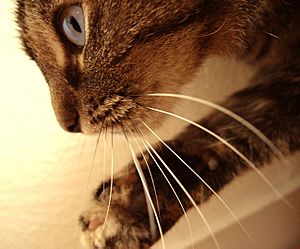Whisker facts for kids
Have you ever wondered about those long, stiff hairs on animals like cats and mice? These are called whiskers! They are special hairs that help animals understand the world around them. Most mammals, like cats, have whiskers around their mouth. Some animals, like cats, also have them above their eyes and on their legs.
It's very important never to cut or trim an animal's whiskers. Cutting them can make the animal confused and unable to feel its way properly. The word "whiskers" can also mean a human beard or mustache, but in animals, they are much more than just hair!
Contents
What Are Animal Whiskers?
Animal whiskers are not just ordinary hairs. They are much thicker and stiffer. They are also deeply rooted in the skin. Each whisker is connected to many nerves and blood vessels. This makes them very sensitive.
Whiskers are also known as vibrissae. This word comes from the Latin word "vibrio," which means "to vibrate." This name is perfect because whiskers help animals sense vibrations and movements in their surroundings.
How Whiskers Help Animals
Whiskers act like tiny antennas for animals. They help them in many ways:
- Feeling their way: Animals use whiskers to feel objects around them. This is especially helpful in the dark or in tight spaces.
- Hunting: Predators like cats use whiskers to find their prey. They can sense tiny movements or air currents made by other animals.
- Balancing: Whiskers can help some animals keep their balance.
- Navigating: Animals can tell how wide a space is by how their whiskers touch the sides. This helps them decide if they can fit through a gap.
Whiskers in Different Animals
Many different animals have whiskers, and they use them in unique ways:
- Cats: A cat's whiskers are very important for hunting and moving around at night. They can even tell if a space is too small for them to fit through.
- Dogs: Dogs have whiskers on their snout, above their eyes, and on their chin. These help them explore their environment.
- Seals: Seals have very sensitive whiskers. They use them to find fish in dark or murky water. They can even detect the tiny movements of fish from far away.
- Mice and Rats: These small rodents constantly move their whiskers back and forth. This helps them build a detailed map of their surroundings.
- Fish: Some fish, like catfish, have whisker-like feelers called "barbels." They use these to find food in the mud or on the bottom of rivers.
Why Whiskers Should Not Be Cut
It is very important not to cut or trim an animal's whiskers. Whiskers are not just for looks. They are vital sensory organs. If an animal's whiskers are cut, it can become disoriented. It might have trouble moving around. It could also struggle to hunt or find its way in the dark. This can be very stressful and dangerous for the animal.
Images for kids
-
The "whiskers" around the beak of a kakapo.
-
A Patagonian fox showing four major cranial groups of vibrissae: supraorbital (above the eye), mystacial (where a moustache would be), genal (on the cheek, far left), and mandibular (pointing down, under the snout).
-
Macrovibrissae and supraorbital vibrissae of Phoca vitulina.
-
A yawning cat shows how the mystacial macrovibrissae can be swept forward.
See also
 In Spanish: Vibrisas para niños
In Spanish: Vibrisas para niños








